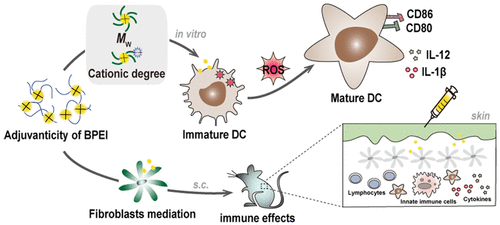当前位置:
X-MOL 学术
›
ACS Appl. Polym. Mater.
›
论文详情
Our official English website, www.x-mol.net, welcomes your feedback! (Note: you will need to create a separate account there.)
Intrinsic Adjuvanticity of Branched Polyethylenimine In Vitro and Subcutaneously
ACS Applied Polymer Materials ( IF 5 ) Pub Date : 2020-02-25 , DOI: 10.1021/acsapm.9b01016 Chen Shen 1 , Yujie Gao 2 , Jun Li 1 , Hongyao Du 1 , Ruijing Liang 2 , Yanhong Sun 1 , Jun Xie 2 , Liyun Dong 1 , Yamin Zhang 1 , Jinjin Zhu 1 , Bo Zhang 3 , Guanxin Shen 4 , Xiang Chen , Jintao Zhu 2 , Juan Tao 1
ACS Applied Polymer Materials ( IF 5 ) Pub Date : 2020-02-25 , DOI: 10.1021/acsapm.9b01016 Chen Shen 1 , Yujie Gao 2 , Jun Li 1 , Hongyao Du 1 , Ruijing Liang 2 , Yanhong Sun 1 , Jun Xie 2 , Liyun Dong 1 , Yamin Zhang 1 , Jinjin Zhu 1 , Bo Zhang 3 , Guanxin Shen 4 , Xiang Chen , Jintao Zhu 2 , Juan Tao 1
Affiliation

|
Branched polyethylenimine (BPEI) is a cationic polymer and has been applied as an antigen carrier in vaccines. However, its intrinsic adjuvanticity and underlying mechanism remain unclear. Here, we systematically explored the direct stimulation effects of a series of BPEI on bone-marrow-derived dendritic cells (BMDCs) in vitro. Only high concentrations of BPEI with molecular weight (MW) equal to or greater than 25 kDa showed an immune-activating effect, indicating that both MW and cationic degree contribute to this effect. In a charge neutralization experiment, the intrinsic adjuvanticity of BPEI also demonstrated a cationic degree-dependent pattern. Moreover, we identified reactive oxygen species (ROS) as the crucial messengers in BPEI-mediated BMDC activation. However, high MW and cationic charges from the BPEI exerted a direct toxicity on dendritic cells, which would restrict its in vivo applications. Therefore, we introduced fibroblasts as bystander cells and found that BPEI-treated fibroblasts passed stimulation effects to BMDCs with undetectable cytotoxicity. During subcutaneous stimulation, which corresponded to the fibroblast-mediated coculture system, BPEI induced an inflammatory microenvironment and local immune cell infiltration without obvious cell death. To the best of our knowledge, this is the first systematic and incisive investigation of BPEI’s intrinsic adjuvanticity and its functional exploration in the presence of bystander cells. This finding paves the way to advance the BPEI-based vaccines and will give insights into the use of other immunoactive biomaterials with similar properties.
中文翻译:

分支聚乙烯亚胺的内在和体外皮下佐剂
支链聚乙烯亚胺(BPEI)是一种阳离子聚合物,已被用作疫苗中的抗原载体。但是,其内在的辅助性和潜在的机制仍不清楚。在这里,我们系统地探讨在骨髓来源的树突细胞(BMDC的)一系列BPEI的的直接刺激作用在体外。只有高分子量(M W)等于或大于25 kDa的BPEI才显示出免疫激活作用,表明这两种M W阳离子度有助于此效果。在电荷中和实验中,BPEI的固有佐剂性也显示出阳离子度依赖性模式。此外,我们确定了活性氧(ROS)作为BPEI介导的BMDC活化的关键信使。然而,高中号W¯¯并从BPEI阳离子电荷作用于树突状细胞的直接毒性,这将限制它的体内应用程序。因此,我们引入了成纤维细胞作为旁观者细胞,发现经BPEI处理的成纤维细胞将刺激作用传递给了BMDC,而细胞毒性却无法检测到。在对应于成纤维细胞介导的共培养系统的皮下刺激过程中,BPEI诱导了炎性微环境和局部免疫细胞浸润,而没有明显的细胞死亡。据我们所知,这是对BPEI内在佐剂性及其在旁观者细胞存在下的功能探索的首次系统和深入研究。该发现为开发基于BPEI的疫苗铺平了道路,并将为使用其他具有类似特性的免疫活性生物材料提供见解。
更新日期:2020-02-25
中文翻译:

分支聚乙烯亚胺的内在和体外皮下佐剂
支链聚乙烯亚胺(BPEI)是一种阳离子聚合物,已被用作疫苗中的抗原载体。但是,其内在的辅助性和潜在的机制仍不清楚。在这里,我们系统地探讨在骨髓来源的树突细胞(BMDC的)一系列BPEI的的直接刺激作用在体外。只有高分子量(M W)等于或大于25 kDa的BPEI才显示出免疫激活作用,表明这两种M W阳离子度有助于此效果。在电荷中和实验中,BPEI的固有佐剂性也显示出阳离子度依赖性模式。此外,我们确定了活性氧(ROS)作为BPEI介导的BMDC活化的关键信使。然而,高中号W¯¯并从BPEI阳离子电荷作用于树突状细胞的直接毒性,这将限制它的体内应用程序。因此,我们引入了成纤维细胞作为旁观者细胞,发现经BPEI处理的成纤维细胞将刺激作用传递给了BMDC,而细胞毒性却无法检测到。在对应于成纤维细胞介导的共培养系统的皮下刺激过程中,BPEI诱导了炎性微环境和局部免疫细胞浸润,而没有明显的细胞死亡。据我们所知,这是对BPEI内在佐剂性及其在旁观者细胞存在下的功能探索的首次系统和深入研究。该发现为开发基于BPEI的疫苗铺平了道路,并将为使用其他具有类似特性的免疫活性生物材料提供见解。



























 京公网安备 11010802027423号
京公网安备 11010802027423号